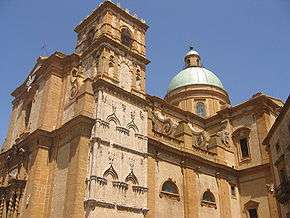Piazza Armerina
| Piazza Armerina | ||
|---|---|---|
| Comune | ||
| Città di Piazza Armerina | ||
|
| ||
| ||
 Piazza Armerina Location of Piazza Armerina in Italy | ||
| Coordinates: 37°23′N 14°22′E / 37.383°N 14.367°ECoordinates: 37°23′N 14°22′E / 37.383°N 14.367°E | ||
| Country | Italy | |
| Region | Sicily | |
| Province | Enna (EN) | |
| Frazioni | Azzolina, Farrugio, Floristella, Grottacalda, Ileano, Polleri, Santa Croce, Serrafina | |
| Government | ||
| • Mayor | Nino Cammarata | |
| Area | ||
| • Total | 302 km2 (117 sq mi) | |
| Elevation | 697 m (2,287 ft) | |
| Population (30 November 2017) | ||
| • Total | 21,768 | |
| • Density | 72/km2 (190/sq mi) | |
| Demonym(s) | Piazzesi | |
| Time zone | UTC+1 (CET) | |
| • Summer (DST) | UTC+2 (CEST) | |
| Postal code | 94015 | |
| Dialing code | 0935 | |
| Patron saint | Maria Santissima della Vittoria | |
| Saint day | August 15 | |
| Website | Official website | |
Piazza Armerina (Gallo-Italic of Sicily: Ciazza; Sicilian: Chiazza) is a comune in the province of Enna of the autonomous island region of Sicily, southern Italy.
History
The city of Piazza (as it was called before 1862) developed during the Norman domination in Sicily (11th century), when Lombards settled the central and eastern part of Sicily.
But the area had been inhabited since prehistoric times. The city flourished during Roman times, as shown by the large mosaics at the patrician Villa Romana del Casale.

Remains, artifacts of old settlements and a necropolis from the 8th century BC were found in the territory of the commune.
Main sights
The town is famous chiefly for its Roman mosaics in the Villa Romana del Casale, about 3 kilometres (2 miles) to the southwest. It has a range of significant architecture dating from medieval through the 18th century. The discovery and excavation of the well-preserved, highly refined mosaics has helped attract tourists.
The medieval history of the city is manifest in some of its houses, which show Norman or Gothic architecture. The main landmarks include a range of architectural styles:
- The massive Baroque cathedral (17th and 18th centuries), built on the 15th-century foundations of a former church, from which the bell tower was taken and reused.[1] Also original to the 15th-century church are the Catalan-Gothic style windows on the left side. The dome dates from 1768. The façade has a notable portal with spiral columns by Leonardo De Luca. The interior, with a single large nave, houses the Madonna della Vittoria (Madonna of the Victory). The Byzantine icon is traditionally associated with the banner donated by the Pope to Roger I of Sicily during the Council of Melfi. The cathedral has an unusual two-sided crucifix by an unknown artist. The Diocesan Museum holds reliquiaries, articles of silverware, monstrances and other religious art works.[2]
- The nearby Palazzo Trigona, house of the wealthy family who commissioned the church.
- The Church of Fundrò, known also as St. Roch, with a carved tufa portal.
- The nearby Palazzo di Città (1613), characterized by a fresco ceiling by Salvatore Martorana.
- The massive Aragonese Castle (1392–96). It is square in shape, with square towers.
- The church of San Giovanni Evangelista (14th century), with an interior covered with frescos by Guglielmo Borremans and assistants.
- The baroque church of Sant'Anna (18th century), with its original sinuous façade inspired by the buildings of Borromini.
- The church of St. Martin of Tours (1163).
- The church of Santa Maria di Gesù (16th century), now abandoned.
- The Garibaldi Theatre.
Outside the city is the ancient church of the Priorato di Sant'Andrea (1096), founded by Count Simon of Butera, a nephew of Roger I of Sicily. It has important medieval frescoes.
Culture
Piazza Armerina holds an annual Palio dei Normanni, a re-enactment in costume of the entrance of the Norman Count Roger I to the city. It takes place on 12–14 August.
Language
Piazza Armerina is one of the so-called "Lombard" communes of Sicily, as its dialect differs notably from that of the neighbouring region. This is due to the destruction of the old Piazza by king William I of Sicily, and the subsequent repopulation by William II (according to other scholars, during the slightly later age of Frederick II) with colonists coming from northern Italy (then collectively called "Lombardy"), especially from Monferrato and Piacenza.
References
- ↑ Piazza Armerina
- ↑ Mauceri, Enrico (1906). "Armerina Piazza". L'Arte. 9: 14–17. (in Italian)

Sources
- La Rosa, Ugo (1993). Sicily and Its Islands.
External links
| Wikimedia Commons has media related to Piazza Armerina. |

- Official website
- Villa Romana del Casale website (in Italian)
- Piazza Armerina, city of Mosaics

